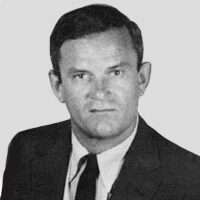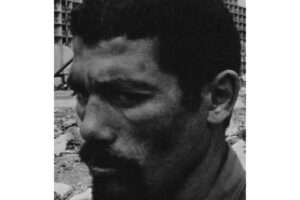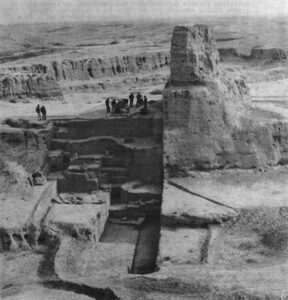Richard Critchfield
- 1970

Fellowship Title:
- Food Population Crisis in India, Indonesia and Iran
Fellowship Year:
- 1970

The Marginal Men
The marginal ten, the wretched stragglers for survival on the fringes of farm and city, may already number half a billion. By 1980 they will surpass a billion, by 1990 two billion. Can we imagine any human order surviving with so gross a mass of misery piling up at its base? — Robert S. McNamara in a speech to the World Bank’s board of governors, 1970 The last time I saw Paris Her heart was young and gay I saw the laughter in her eyes In every street café… (Introductory note: This is the fifth and last case study in this series of articles exploring – in the daily lives of ordinary people – the human impact of overpopulation. The previous four studies dealt with the problem’s historical development, the first true Malthusian breakdown, the transfer of farm technology and urbanization. This study concerns emigration and the confrontation between the poor countries and the rich as revealed in a journey from a green valley in the Maghreb into the Arab slums of Casablanca and Paris.
It’s a Revolution All Right
Rome May 2, 1971 The disintegration of Pakistan. The collapse of a government in Turkey. Heightened rural violence in the Philippines. Is it mere coincidence that political explosions have followed spectacular advances in agricultural production in all three countries? From the perspective of the Food and Agricultural Organization’s global conning tower in Rome the answer seems to be no. The civil war in Pakistan, especially, has led to a sober reappraisal, not only of the “green revolution” based on the new dwarf grains, heavy fertilization and irrigation, but of the widely accepted view that, breakthroughs in food output have given the world twenty or thirty years “breathing space” in which to check population growth. Although the evidence is still very tentative, FAO policy planners and economists are beginning to fear that runaway population growth is once more edging ahead in the race with world food production. Indeed, the slowdown of the green revolution, its failure to take hold in some regions with the most severe population problems such as North Africa and the

How Lonely Sits The City – Part II
Le Témoin Suse, capitale de l’Elam, est situe’ dans la province autrefois fertile du Khuzistan qui prolonge, en Iran, la grande plaine arrosee par le Tigre et l’Euphrate. Aussi sa civilization est elle plus etroitement lies a Celle de la Mesopotamie qu’a celle du Plateau Iran…. Au 13 siecle la celebre ville dont les vestiges presentent un exemple de continuite peut-etre unique dans l’histoire des civilisations, fut abandonee…. Il y a une trentaine d’annees, encore Suse ne comptait plus que quelques maisons groupees autour du tombeau de Daniel. Depuis, cet humble village ne cess de s’agrandier.Peut-etre qu’un jour, graceaux travaux d’irrigation entrepris dans la region, l’antique cite’ retrouvera-t-elle l’éclat de sa grandeur passée.A brochure of the French Archeological Mission in Iran, 1971 Listen again. One Evening at the CloseOf Ramazan, ere the better Moon arose,In that old Potter’s Shop I stood aloneWith the clay Population round in Rows.And, strange to tell, among that Earthen LotSome could articulate, while others not;And suddenly one more impatient cried –“Who is the Potter, pray, and who the Pot?”Then said

How Lonely Sits The City – Part I
A Survey in Two Parts of the Human Impact of Agricultural Development from Prehistoric to Contemporary Times as seen from the Village of Shush-Daniel on the Khuzestan Plain of Southwest Persia Contents Part One: 10,000 to 640 B.C. – Bedouin. PartTwo: Le Temoin – 640 B.C. to the Present – Fellahin The Temple in the Desert Appendix Introductory Note; This report differs from others in this series on food and population in that it is an experiment to see what light can be shed on the previously explored issues of technological revolution, urbanization and the uprooting of people, through a short survey of their historical past. There is consequently, no principal group of characters. Rather this report comprises six sketches, two of them historical exposition and four separate through related scenes of contemporary life, based on dialogue recorded in or around Shush-Daniel village between late December 1970 and early March 1971. Shush-Daniel is today a small settlement of about seven thousand Kurd, Lur and Arab peasants and Bedouins; it is the site of ancient
A Few Reflections: (Pakistan’s Elections, Tolstoy and Urbanization, & Oscar Lewis)
Pakistan’s Elections Tolstoy and Urbanization Oscar Lewis Teheran, December 27, 1970 Last July the FAO’s director general, Dr. Addeke H. Boerma, warned the Second World Food Congress as quoted in a previous newsletter – that unless the agricultural revolution in the poor countries was carefully managed the result might be “a conflagration of violence that would sweep through millions of lives.” What is happening now in West Pakistan, the show piece and trail blazer in the so-called “green revolution” in dwarf strains of wheat end rice and fertilization, is a case in point. I have just completed a two-week visit to West Pakistan, which I frequently covered as a Delhi-based correspondent in the early sixties but had not visited since 1964. My intention was to spend some days in the village where the subjects of my study of the green revolution on the Indian side of the Punjab plain – Charan and his Sikh community – had lived before India was partitioned in 1947. I assumed quite mistakenly – that little had changed in six
